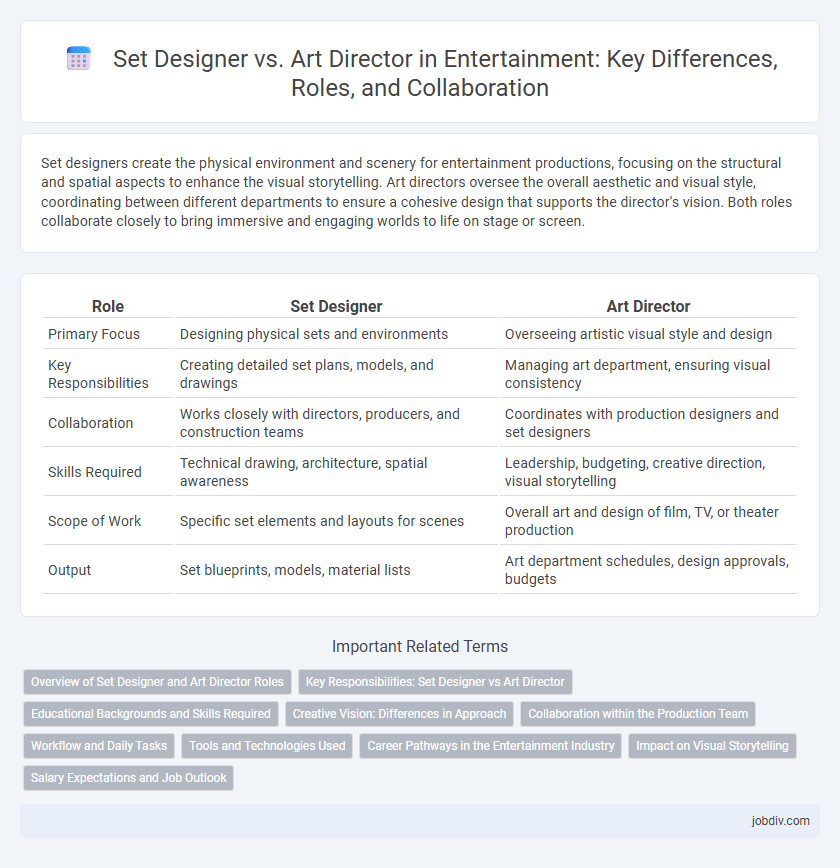Set designers create the physical environment and scenery for entertainment productions, focusing on the structural and spatial aspects to enhance the visual storytelling. Art directors oversee the overall aesthetic and visual style, coordinating between different departments to ensure a cohesive design that supports the director's vision. Both roles collaborate closely to bring immersive and engaging worlds to life on stage or screen.
Table of Comparison
| Role | Set Designer | Art Director |
|---|---|---|
| Primary Focus | Designing physical sets and environments | Overseeing artistic visual style and design |
| Key Responsibilities | Creating detailed set plans, models, and drawings | Managing art department, ensuring visual consistency |
| Collaboration | Works closely with directors, producers, and construction teams | Coordinates with production designers and set designers |
| Skills Required | Technical drawing, architecture, spatial awareness | Leadership, budgeting, creative direction, visual storytelling |
| Scope of Work | Specific set elements and layouts for scenes | Overall art and design of film, TV, or theater production |
| Output | Set blueprints, models, material lists | Art department schedules, design approvals, budgets |
Overview of Set Designer and Art Director Roles
Set designers specialize in creating the physical surroundings on a film or theater stage, crafting environments that enhance storytelling through detailed sketches, models, and construction plans. Art directors oversee the visual style and artistic elements of a production, coordinating with set designers, costume designers, and lighting teams to ensure a cohesive aesthetic vision. Both roles are crucial in shaping the visual narrative but focus on different aspects of design and creative leadership within the entertainment industry.
Key Responsibilities: Set Designer vs Art Director
Set Designers focus on creating and constructing the physical environments for film, television, and theater productions, crafting detailed blueprints, selecting materials, and overseeing set construction to ensure visual coherence. Art Directors manage the overall visual style, coordinating with production designers, costume designers, and lighting teams to maintain artistic consistency and execute the director's vision across all visual elements. Both roles are crucial in shaping the aesthetic and mood of a production, with Set Designers emphasizing physical space and Art Directors on the broader visual narrative.
Educational Backgrounds and Skills Required
Set designers often have formal education in theater design, interior design, or architecture, emphasizing skills in spatial planning, artistic visualization, and technical drawing. Art directors typically possess a background in graphic design, fine arts, or visual communications, requiring expertise in team leadership, creative concept development, and project management. Both roles demand proficiency in software like CAD or Adobe Creative Suite and a strong understanding of color theory, lighting, and materials.
Creative Vision: Differences in Approach
Set Designers concentrate on crafting tangible environments that bring the narrative to life through spatial arrangement and detailed physical elements. Art Directors oversee the broader visual style, ensuring consistency by coordinating artistic teams and aligning designs with the director's overall vision. The divergence in creative vision lies in the Set Designer's micro-level focus on physical settings versus the Art Director's macro-level management of the entire visual aesthetic.
Collaboration within the Production Team
Set designers and art directors maintain a dynamic collaboration within the production team, merging creative visions to establish the visual essence of a project. Set designers focus on constructing immersive environments that align with narrative requirements, while art directors oversee the overall aesthetic coherence and manage the art department's workflow. Effective communication between these roles ensures seamless integration of design elements, enhancing storytelling and maintaining a consistent artistic style throughout the production.
Workflow and Daily Tasks
Set designers develop detailed plans and blueprints for the physical environment of a production, focusing on aesthetics, spatial functionality, and historical accuracy to enhance the storytelling. Art directors oversee the visual style, coordinating between set designers, prop masters, and costume designers to ensure cohesive artistic vision and timely execution. Daily tasks for set designers involve drafting and model-making, while art directors manage schedules, approve design elements, and troubleshoot visual discrepancies on set.
Tools and Technologies Used
Set Designers primarily utilize 3D modeling software like SketchUp and AutoCAD to create detailed layouts and spatial arrangements for film, theatre, and TV productions. Art Directors rely heavily on digital design tools such as Adobe Creative Suite for visual concept development and project management platforms like Shotgun to coordinate production workflows. Both roles incorporate emerging technologies like virtual reality (VR) for immersive set visualization and collaborative design processes.
Career Pathways in the Entertainment Industry
Set designers in the entertainment industry focus on creating the visual environment of a production by crafting detailed and functional set pieces, while art directors oversee the overall visual style and coordinate the artistic team. Career pathways for set designers often begin with specialized education in theater design or architecture, followed by hands-on experience with theater companies or film productions. Art directors typically advance through roles such as production designer or assistant art director, leveraging strong leadership skills and a broad understanding of visual storytelling.
Impact on Visual Storytelling
Set designers craft immersive environments that shape the mood and authenticity of scenes, directly influencing the audience's emotional engagement. Art directors oversee the visual style and cohesion of a production, ensuring that all design elements align with the narrative's tone and themes. Their collaboration enhances visual storytelling by combining spatial creativity with overall aesthetic direction, creating a compelling and believable world for viewers.
Salary Expectations and Job Outlook
Set designers typically earn an average salary ranging from $50,000 to $80,000 annually, reflecting their specialized skills in creating physical environments for productions. Art directors in the entertainment industry often command higher salaries, approximately $70,000 to $120,000 per year, due to their broader responsibility for visual style and cohesive artistic vision. Job outlook for both roles is positive, with a projected growth rate of around 4-6% over the next decade, driven by increasing demand in film, television, and streaming services.
Set Designer vs Art Director Infographic

 jobdiv.com
jobdiv.com